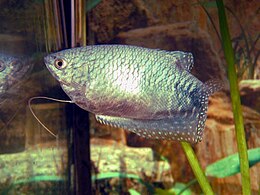| Trichopodus | |
|---|---|

| |
| a blue morph of the three spot gourami (T. trichopterus) | |
|
Scientific classification
| |
| Domain: | Eukaryota |
| Kingdom: | Animalia |
| Phylum: | Chordata |
| Class: | Actinopterygii |
| Order: | Anabantiformes |
| Family: | Osphronemidae |
| Subfamily: | Luciocephalinae |
| Genus: |
Trichopodus Lacépède, 1801 |
| Type species | |
|
Labrus trichopterus | |
| Synonyms [2] | |
Trichopodus (formerly included in Trichogaster [3] [4]) is a genus of tropical freshwater labyrinth fish of the gourami family found in Southeast Asia. Gouramis of the genus Trichopodus are closely related to those of Trichogaster (formerly Colisa); species of both genera have long, thread-like pelvic fins (known as "feelers" in the aquarium trade) used to sense the environment. However, Trichopodus species have shorter dorsal fin base and, when sexually mature, are much larger, with the largest, the snakeskin gourami (T. pectoralis), capable of reaching a length of over 8 in (20 cm). [5]
Along with the Trichogaster species, Trichopodus gouramis are popular in the aquarium trade. The three spot gourami (T. trichopterus), with its several aquarium variants, each known by a different trade name, is perhaps the most common aquarium gourami. Trichopodus species are also used as food fish in its native range. [5] The snakeskin gourami, in particular, is one of the top five aquacultured freshwater fish in Thailand. [6]
Etymology
The name Trichopodus is composed of the Ancient Greek words θρίξ (thríx) which means hair and πούς (poús) which means foot.
Species
There are currently 6 recognized species in this genus: [7]
- Trichopodus cantoris Günther 1861
- Trichopodus leerii Bleeker, 1852 (Pearl gourami)
- Trichopodus microlepis Günther, 1861 (Moonlight gourami)
- Trichopodus pectoralis Regan, 1910 (Snakeskin gourami)
- Trichopodus poptae Low, H. H. Tan & Britz, 2014 [8]
- Trichopodus trichopterus ( Pallas, 1770) (Three spot gourami)
References
- ^ Eschmeyer, William N.; Fricke, Ron & van der Laan, Richard (eds.). "Trichopodus". Catalog of Fishes. California Academy of Sciences. Retrieved 14 December 2019.
- ^ Eschmeyer, William N.; Fricke, Ron & van der Laan, Richard (eds.). "Genera in the family Osphronemidae". Catalog of Fishes. California Academy of Sciences. Retrieved 14 December 2019.
- ^ Töpfer, Jörg; Ingo Schlindler (2009-05-15). "On the type species of Trichopodus (Teleostei: Perciformes: Osphronemidae)" (PDF). Vertebrate Zoology. 59 (1). Dresden: Museum für Tierkunde Dresden: 49–51. ISSN 1864-5755. Retrieved 12 November 2011.
- ^ Paepke, Hans-Joachim (2009-05-15). "The nomenclature of Trichopodus pectoralis Regan, 1910; Trichopodus cantoris Sauvage, 1884 and Osphronemus saigonensis Borodin, 1930 (Teleostei: Perciformes: Osphronemidae)" (PDF). Vertebrate Zoology. 59 (1). Dresden: Museum für Tierkunde Dresden: 53–60. ISSN 1864-5755. Retrieved 12 November 2011.
- ^ a b Pinter, H. (1986). Labyrinth Fish. Barron's Educational Series, Inc., ISBN 0-8120-5635-3
- ^ "National Aquaculture Sector Overview - Thailand". Food and Agriculture Organization of the United Nations.
- ^ Froese, Rainer and Pauly, Daniel, eds. (2019). Species of Trichopodus in FishBase. August 2019 version.
- ^ Low, B.W., Tan, H.H. & Britz, R. (2014): Trichopodus poptae, a new anabantoid fish from Borneo (Teleostei: Osphronemidae). Ichthyological Exploration of Freshwaters, 25 (1): 69-77.